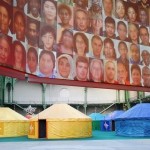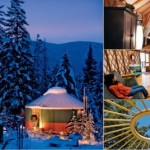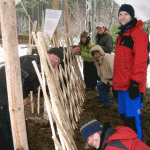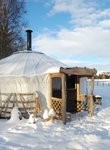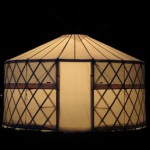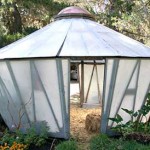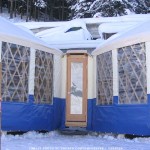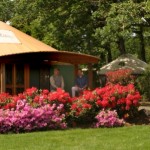
OUR FIRST GUEST BLOG!
When I was working on my book (YURTS:Living in the Round), I found Pete Dolan to be one of the most consistently knowledgeable—and helpful—people in the industry. Pete’s work in Customer Service at Pacific Yurts is one of the reasons their company maintains a legendary reputation for customer satisfaction.
I asked Pete to add his perspective as a guest blogger on the theme of “Buying a Yurt”. Here are his thoughts on
How to Work with a Yurt Company
First, check out company claims
I know these days everybody wants to do all of their research and comparisons online, but keep in mind how easy it is to put together a web site with today’s computers. Someone can put together a web site and make lots of claims without being able to backup or fulfill most of those claims.
It’s important to investigate companies to make sure they are reputable. One way you can do this is by checking with their local Better Business Bureau (www.bbb.org) to see if they have a satisfactory rating. It is worth checking to see if the company has changed their name, too, since this seems to be fairly common and there can be poor ratings for the company under previous names.
Also check web blogs to see if you can find people who have purchased from the companies you are considering in order to find out how satisfied they have been with the quality and service. Checking the company’s rating with Dunn & Bradstreet (www.dnb.com) can also give you a good indication if the company is likely to be around to help you in the future.
If someone’s price seems too good to be true, it probably is. Check the specifications. I’ve seen a number of companies make claims about their products being equal to or better than ours, but their prices were significantly lower. A closer check revealed that inexpensive hardware and fabrics were utilized and the wood frame included far fewer components. For example, one company had up to 32% fewer rafters and lattice in their yurt than our yurt of the same diameter. This can equate to significantly less strength as well.
What’s the biggest mistake people make in buying a yurt? The wrong size? No. You can always add a second yurt if the first turns out to be too small. The wrong style? Not usually. Most of the fabric yurts, for example, are pretty similar to each other, and if you’re buying new you usually get to choose your options and customize it to meet your personal needs.
Last winter I heard from someone who purchased a Mongolian import for a rainforest climate–she’s not having much success since that style of yurt wasn’t designed for her climate. But this is relatively uncommon.
Frankly, yurts aren’t that complicated and there aren’t too many mistakes people make, except perhaps overbuying (snow and wind kits where they aren’t necessary) or underbuying (not getting insulation where it would make a big difference). But none of these mistakes is terribly serious.
The most common mistake I see, and the only one that can be truly devastating, is buying from the wrong company. Devastating in the sense of losing your investment (worst case scenario) or dealing with months of headaches in trying to get your yurt set up and perhaps never getting all the right parts.
Most yurt companies are reputable businesses with a solid product. By far the majority take intense pride in their customer service and your satisfaction. My observation is that even the newest companies (in the middle of their learning curve) will usually bend over backwards to make sure that you are happy with their product and service. Let’s face it–It’s a feel good business and that’s why most people are into it.
However, every once in awhile a company just doesn’t seem able to perform. Yurts won’t arrive when they are supposed to. You’ll have your platform built but then the yurt doesn’t show up for three months–or sometimes it’s 6 months. Meanwhile your platform is sitting there exposed to weather and the elements. The baby that was supposed to be born three months after the yurt arrives is born in a makeshift RV (yes, that’s a true story) three months before the yurt ever shows up.
Coming in March…an “art yurt” at the Smithsonian’s Cooper-Hewitt National Design Museum!
The Cooper-Hewitt exhibit Fashioning Felt, which runs from March 6 through Sept. 7, 2009, will feature a yurt installation by hand-felter Janice Arnold. Arnold (photo at right) will create a palace yurt, inspired by “the traditional dwelling of the tribal leader,” in the museum’s conservatory. The yurt will have a ceremonial entrance; the surrounding glass walls and ceiling of the conservatory will be draped in a soft, felted material of Arnold’s creation.
The Fashioning Felt exhibit provides a comprehensive overview of the uses of felt, with more than 70 works covering themes from historic examples and handmade felt innovations to contemporary industrial uses in fashion, architecture, product design and home furnishings.
The Cooper-Hewitt, National Design Museum is located on Museum Mile at the corner of 91st Street and Fifth Avenue in New York City (2 East 91st Street).
Plans are being made for the exhibit to travel to various locations after the run in at the Cooper-Hewitt.
Yurts in Paris!
In 2003, inspired and organized by renowned French photographer Yann Arthus-Bertand, six directors set off across the world to “interview the inhabitants of the planet” on life’s essential questions. Six thousand interviews later they had visited over 65 countries and filmed over 4500 hours of footage.
 This month 450 hours of translated interviews will be shared with the world through an exhibit titled “6 Billion Others” at the Grand Palais in Paris. The showing takes place in twenty-five yurts set up as individual theaters. Each yurt theater is dedicated to one of 25 fundamental life questions ranging from money to family, love and happiness. Visitors (including over 140 school classes) will wander from yurt to yurt listening to the subtitled interviews and pondering their own relationship to life’s questions.
This month 450 hours of translated interviews will be shared with the world through an exhibit titled “6 Billion Others” at the Grand Palais in Paris. The showing takes place in twenty-five yurts set up as individual theaters. Each yurt theater is dedicated to one of 25 fundamental life questions ranging from money to family, love and happiness. Visitors (including over 140 school classes) will wander from yurt to yurt listening to the subtitled interviews and pondering their own relationship to life’s questions.
Colorado Yurt Company created the yurts in a rainbow of colors and says they are “thrilled and honored” to participate. “Our contemporary re-engineering of the traditional yurt appealed to the artist and designers in Paris,” said owner Emma Kiger. “The yurt structure is simple and elegant, plus it has the allure of a traditional, nomadic dwelling.”
Setting up 25 yurts in Paris Want to see 25 yurts go up in three minutes? Check out this YouTube video! You can also learn more about this amazing project and event at the “6 Billion Others” (6 milliards d’autres) website.
 The show runs from January 11 through February 12. After it closes in Paris there are plans to take the show to other locations, including San Francisco. Keep an eye out–those yurts just might show up in your city!
The show runs from January 11 through February 12. After it closes in Paris there are plans to take the show to other locations, including San Francisco. Keep an eye out–those yurts just might show up in your city!
Many congratulations to Colorado Yurt Company for your participation in this great event!
May 2009 be a great year for everyone in the yurt family…
becky
Sierra Magazine yurt story
People often ask me about my own story–how I first got involved with yurts, why I wrote the book, and so on. You’ll find part of the story in the “Comfort Zone” column of this month’s Sierra Magazine.
And yes, that’s my yurt in photo on the left–in north Idaho, in the winter. It’s beautiful here!
My yurt is currently on loan to a friend, but I hope to have all the parts back by April so I can get it back up this May. Perhaps some of you can come help me put it up? I think we’ll be putting up a smaller yurt at the same time, maybe a tipi or two as well. We’ll post the dates at www.themedicinecircle.org. See you there!
Home is where the yurt is…
becky
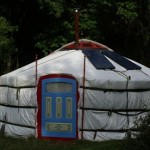 I recently received an email from yurt builder Steve Hammond of Moorestown, New Jersey, with a most generous offer. Steve has built a few Mongolian gers over the years and the “four wall” ger you see on the right is his latest.
I recently received an email from yurt builder Steve Hammond of Moorestown, New Jersey, with a most generous offer. Steve has built a few Mongolian gers over the years and the “four wall” ger you see on the right is his latest.
Well, as Steve put it, he “just got the bug to write down what I found as aids for my particular path”, adding pictures to illustrate. He offered to send me the file so that I could share it with potential yurt builders in the hopes that “readers might find a few insights to their dilemmas in what I have learned from others.”
So here a link for downloading Steve’s Info in Word doc format.
If you’re in North America and are interested in building your own traditional yurt, you might consider attending a workshop with Alex and Selene Cole of Little Foot Yurts in Wolfville, Nova Scotia (Canada).
The 2009 workshops are happening January 9-11 and January 16-18. The two and a half day workshop covers the basics of yurt construction and includes coppicing (a sustainable method of timber harvesting common in Europe). You will leave with the practical skills to start building your own yurt and making your own yurt plans, and the cost is only $250. Families are welcome, too! For the full agenda and registration information go to their website at www.lfy.ca.
Wishing all you builders great success with your projects. Don’t forget to look at the resources listed at www,yurtinfo.org and check out the yurt plans section on our Forum.
Best of luck with your projects,
becky
Holiday Yurt Greetings
In lieu of a Christmas Card, I’d like to forward this enchanting winter photo of a Scottish yurt, sent my way by Paul Spencer of Highland Yurts in Aberdeenshire, Scotland (Paul can be seen at right peeling a log with a draw knife). Paul tells me he will be offering some yurt making workshops this coming year (check the yurtinfo.org Calendar for a posting of workshop dates) and that he’s working on providing yurt camping in the Scottish Highlands.
One of the delights of this season is hearing from yurt builders in all parts of the world–from Europe to China and New Zealand. It’s amazing how broad this yurt phenomenon is. Each place on the planet modifies the design to fit their local climate and lifestyle needs, but all share in that marvelous roundness and sense of uplift.
I hope you are staying cozy in your yurt (or cool in the Southern Hemisphere). May you enjoy a special Solstice, a Merry Christmas and a joyous Holiday Season.
Yurts,
becky
Modern Green Yurt wins Design Award
Congratulations to yurt builder and designer extraordinaire Howie Oakes of Go Yurt Shelters for being First Place Winner of a Portland Spaces Design Award for his Modern Green Yurt.
The Awards article has this to say about the thirteen foot yurt:
Inspired by innovations in sailboat design, Oakes has used breathable
canvas; curved, linseed-oiled birch; and stainless steel hardware to
build a functional and elegant hideaway. The structure can be assembled
by one person in an hour, and the heaviest component weighs a mere 30
pounds.
A true family business, you can read the Go Yurt story here , but don’t try to reach Howie over the Christmas holidays. He’ll be camping with his family on the beaches of Baja–in a yurt, of course.
Tip of the week–don’t forget to pick up an extra hot water bottle at your local drugstore to keep your feet warm this winter! Throw it in your bed 30 minutes before you get in and your bed will be toasty warm.
Home is where the yurt is,
becky

 One of my favorite publishers is Shelter Publications of Bolinas, California. Remember the book Shelter (left), which inspired so many handmade houses in the 1960’s and ’70’s? Then came Home Work (right), the pictorial record of 35 years of those inspired handbuilt houses–the ultimate dream book.
One of my favorite publishers is Shelter Publications of Bolinas, California. Remember the book Shelter (left), which inspired so many handmade houses in the 1960’s and ’70’s? Then came Home Work (right), the pictorial record of 35 years of those inspired handbuilt houses–the ultimate dream book.
Now there’s a new release, Builders of the Pacific Coast.
 Reviewer Mike Litchfield says,
Reviewer Mike Litchfield says,
…on every page is something shocking and delightful. A boat with legs. A roof like a leaf. A caravan with eyes. A split-cedar woodshed shaped like a bird. Stair rails so sinuous and snakey they might come to life and grab you. Sculpted earth walls. Round windows and arched doors. Roofs curved like seagull wings. Grottos choked with ferns and flowers…
Check it out for yourself at www.shelterpub.com.
You’ll also want to see publisher Lloyd Kahn’s blog for more photos of this tapered wall greenhouse (Oct. 31 post), plus wonderful stories of his travels and lots of amazing shelter images.
Yurts and cold climates
One of the questions I get asked the most is, “Do yurts work in cold climates?”
Yes they do. All my yurt living has been done in the mountains of the Pacific Northwest, and I’ve found yurts to be very cozy and efficient to heat. Like any home, you have to do some insulating and cover up those drafty spots (I hang recycled theatre curtains over my yurt windows in the winter).
If you want to get a glimpse of yurt life in a truly cold climate (“Our nighttime temps fall to -25 to -30 F…”), check out the amazing blog Yurts N Dogs, the ongoing story of a yurt family in Alaska. Right now hubby Rick is racing in the Iditarod (dogsled race), so it’s an exciting time to check in.
And there’s a nice little piece on Mongolian vacation choices and The Concept of Havuu from a travelers’ blog.
Be warm, be well, and remember…
Home is where the yurt is….



